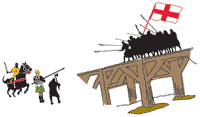| | Home | Resources | Schools Programme | Teachers | Site help | About us | Contact us | |
| You are here: Home > Resources > Scottish Wars of Independence > William Wallace, Guardian of the Realm, 1297-1298 |
Unit 3: William Wallace, Guardian of the Realm, 1297-1298 In May 1297, armed resistance to English occupation broke out in Scotland. William Wallace killed William Heselrig, the English sheriff of Lanark, while Andrew Murray attacked Urquhart Castle in the north. On 11 September 1297, Wallace and Murray defeated the English army at the battle of Stirling Bridge and took over the reins of government. As military leaders of the Scottish cause, they needed to secure political allies and re-open Scottish ports to business with Europe. On 11 October 1297, they wrote to Lübeck and Hamburg encouraging German merchants to resume trading with Scotland. 
Andrew Murray died in November 1297 from wounds received at the battle of Stirling Bridge. In March 1298, William Wallace remained sole Guardian of Scotland with the support of the community of the Scottish realm, which included barons and leading clergy. View the timeline of events in the Scottish Wars of Independence | ||||
Source 1: The Lübeck Letter, 1297 | ||||
Source 2: The Scrymgeour Charter, 1298 | ||||
|
|